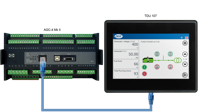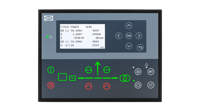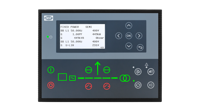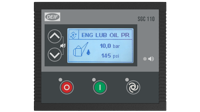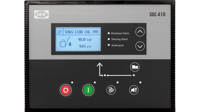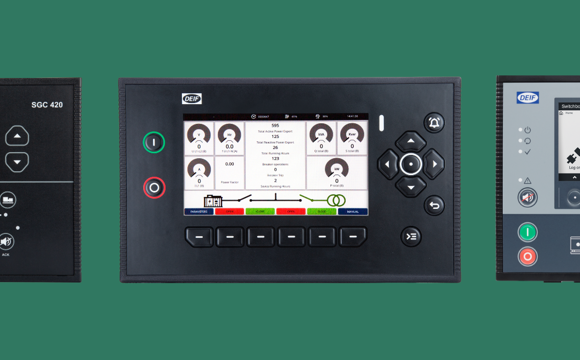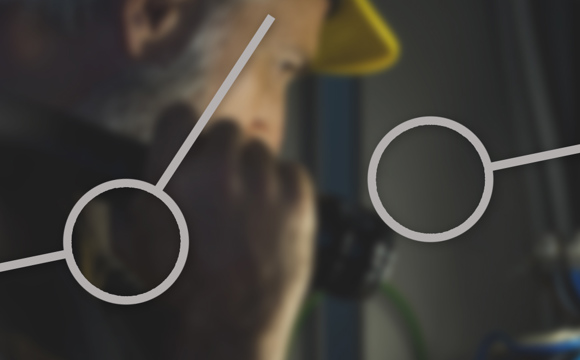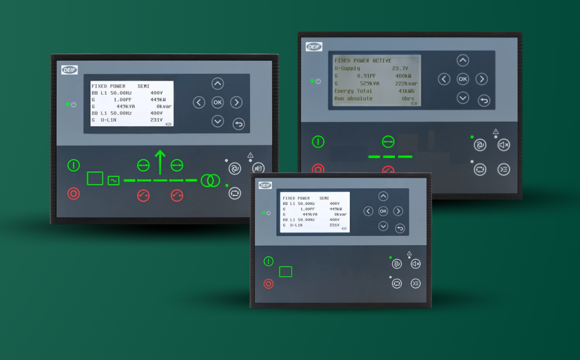Troubleshooting AC protections
It’s a dark and stormy night. Suddenly a controller’s red light starts flashing. There’s an alarm! What should you do?
We have compiled this list of common alarms and what causes them. We hope that you will never have to use it; however, we also hope that this list will prove useful in the event that you do need it.
Some alarms seem easy enough to troubleshoot. Let’s start with a relatively simple example.
What causes over-current alarms?
Over-current (also known as 3I>, ANSI 50TD, and PTOC) means that there is too much current from the generator. The high current is most probably due to the generator supplying a large load. Depending on the settings, the overload alarm (also known as P>, ANSI 32, and PDOP) might also be activated.
The large load might be caused by the start of a motor with a high current, another generator tripping, or faulty load sharing. Alternatively, there may be a large capacitive or inductive load.
But what about the more complex alarms? Keep reading …
What causes under-excitation alarms?
An under-excitation alarm is caused by negative reactive power from the generator. Under-excitation is also known as reactive power import, loss of excitation, -Q>, ANSI 40U, and PUEX. Negative reactive power can occur when a large capacitive reactive load is connected, for example capacitors. Long cables can also act as a capacitive reactive load.
If the generator’s excitation is relay controlled, the AVR Up relay may have stopped working. The AVR itself may be faulty. Finally, under-excitation may be caused by an incorrect AVR set point.
What causes over-excitation alarms?
An over-excitation alarm is caused by high reactive power from the generator. Over-excitation is also known as reactive power export, Q>, ANSI 40O, and POEX. High reactive power can occur when an inductive reactive load is connected, for example a motor. The load draws voltage from the generator, temporarily lowering the voltage and forcing the generator to compensate by increasing excitation.
If the generator’s excitation is relay controlled, the AVR Down relay may have stopped working. The AVR itself may be faulty. Finally, over-excitation may be caused by an incorrect AVR set point.
What causes unbalance alarms?
Unbalance alarms can occur for generator voltage, current, and busbar voltage.
Generator voltage unbalance alarms are also known as voltage asymmetry, UUB>, and ANSI 47. They are caused by unbalanced generator phase voltages. A relatively big load on one phase can cause a generator voltage unbalance. Check for current unbalance. Unbalanced generator phase voltages can also be due to a faulty generator, or one or more faulty voltage measurements (for example, a broken or disconnected wire).
Current unbalance alarms are also known as IUB>, and ANSI 46. They are caused by unbalanced generator phase currents. A relatively big load on one phase can cause a current unbalance. Check for generator voltage unbalance. Unbalanced generator phase voltages can also be due to a faulty generator.
Busbar voltage unbalance alarms are also known as voltage asymmetry, UUB>, and ANSI 47. They are caused by unbalanced busbar phase voltages. A relatively big load on one phase can cause a busbar voltage unbalance. Check for current unbalance. Unbalanced busbar phase voltages can also be due to a faulty generator, or one or more faulty voltage measurements (for example, a broken or disconnected wire).
What causes negative sequence alarms?
The highly technical explanation is that negative sequence alarms are activated when the virtual representation of the phase rotation for an unbalanced system appears negative.
Fortunately, the root causes of this situation are easier to understand. Single-phase loads can activate negative sequence alarms. Unbalanced line short circuits and open conductors can also activate negative sequence alarms, as can unbalanced phase-to-phase or phase-to-neutral loads.
Both negative sequence voltage and negative sequence current alarms are possible. Negative sequence voltage is also known as ANSI 47, and PNSC. Negative sequence current is also known as ANSI 46, and PUBC.
What causes zero sequence alarms?
Zero sequence alarms are activated when the vector zero value (star point) is displaced. This displacement is caused by an earth fault. Both zero sequence voltage and zero sequence current alarms are possible.
Zero sequence voltage is also known as ANSI 59Uo, and PZOV. Zero sequence current is also known as ANSI 51Io, and PTOC.
What causes inverse-time over-current alarms?
The highly technical explanation is that alarm response time depends on an approximated integral of the current measurement over time. The integral is only updated when the current measurement is above the activation threshold.
Put more simply, inverse-time over-current alarms provide a type of thermal protection. When excess current flows over time, this heats up the equipment. Inverse-time over-current alarms are good at detecting not only the damage that can be done by a high current for a short time, but also the damage that can be done by a lower over-current over a longer time.
For a generator, inverse-time over-current is also known as It>, ANSI 51, and PTOC.
If there is a current measurement on the earth connection, an earth inverse-time over-current alarm can be configured. This is also known as ANSI 51G. The root mean squared (RMS) should be filtered to attenuate the third harmonic. This alarm is activated if there is an earth leakage.
If there is a current measurement on the neutral line, a neutral inverse-time over-current alarm can be configured. This is also known as ANSI 51N. This alarm is activated if the phases are unbalanced.
What causes directional over-current alarms?
Directional over-current alarms (also known as ANSI 67, and PTOC) are activated based on the measured current, with the direction from the active power.
If the set point for this alarm is positive, then it is activated by the same root causes as over-current.
If the set point for this alarm is negative, then it is activated by the same root causes as reverse power.
What causes reverse power alarms?
Reverse power is also known as -P>, ANSI 32R, and PDRP. Normally, active power flows from the generator. During a reverse power alarm, active power flows to the generator.
Reverse power can occur after synchronisation if the engine is unable to keep up the required speed, for example because it is running out of fuel or as a result of issues with the fuel filters, the governor, or other mechanical components. It can also be the result of unstable load sharing.
How can I troubleshoot if there are lots of alarms?
Sometimes a single event can activate multiple alarms. For example, a high current can simultaneously activate over-current, fast over-current, inverse-time over-current, and directional over-current. In this example, troubleshooting is relatively easy. The operator only has to figure one thing out: Why was there a high current?
Sometimes, a sequence of events can activate multiple alarms. These situations can require careful analysis, and the logs can be helpful.
What should I do with all the alarms during commissioning?
While getting a lot of alarms during commissioning may at first seem undesirable and overwhelming, these are actually very helpful for checking the installation.
During commissioning, there may be problems with hardware, wiring, configuration, and regulation. These can activate alarms that would not otherwise be activated. For example, you could get a neutral inverse-time over-current alarm (ANSI 51N) even though the phases are not unbalanced. The alarm could be activated during commissioning because the current transformers are configured incorrectly, the nominal neutral current is too low, and/or the alarm set point is too low. A step-by-step and logical approach will help you to find the root causes, so that you can fix the problems.
We hope that all is well in your power generation system. If it isn’t, we are ready help you: contact us to discuss your options for a service visit.
Links
What does “normally energised” and “normally de-energised” mean? Check out this blog post
Download our FREE whitepaper on keeping your emergency power systems fit
-

Contact us to discuss your options
- 90 years of energy pioneering
- Manufactured at the highest standards
- Superior quality
- Unmatched service and support
- Made in Denmark




